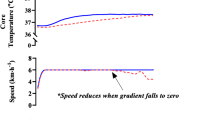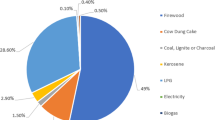Abstract
Current thermal comfort indices do not take into account the effects of wind and body movement on the thermal resistance and vapor resistance of clothing. This may cause public health problem, e.g. cold-related mortality. Based on the energy balance equation and heat exchanges between a clothed body and the outdoor environment, a mathematical model was developed to determine the air temperature at which an average adult, wearing a specific outdoor clothing and engaging in a given activity, attains thermal comfort under outdoor environment condition. The results indicated low clothing insulation, less physical activity and high wind speed lead to high air temperature prediction for thermal comfort. More accurate air temperature prediction is able to prevent wearers from hypothermia under cold conditions.



Similar content being viewed by others
References
Ali-Toudert F, Mayer H (2006) Numerical study on the effects of aspect ratio and orientation of an urban street canyon on outdoor thermal comfort in hot and dry climate. Build Environ 41:94–108
Arciero PJ, Goran MI, Poehlman ET (1993) Resting metabolic rate is lower in women than in men. J Appl Physiol 75:2514–2520
Arens E, Bosselmann P (1989) Wind, sun and temperature-predicting the thermal comfort of people in outdoor spaces. Build Environ 24:315–320
ASHRAE (2004) ASHRAE Standard 55 thermal environmental conditions for human occupancy. American Society of heating, refrigerating, and air conditioning engineers, Atlanta, GA
ASHRAE (2005) ASHRAE Handbook Fundamentals (SI ed.). American Society of Heating, Refrigerating, and Air Conditioning Engineers, Atlanta, GA
ASTM (2005) ASTM F1291 Standard test method for measuring the thermal insulation of clothing using a heated manikin. American Society for Testing and Materials Annual Book of ASTM Standards-Part 11.03 Conshohocken, PA
Burton AC, Edholm OG (1955) Man in a cold environment. Arnold, London
Cunningham J (1980) A reanalysis of the factors influencing basal metabolic rate in normal adults. Am J Clin Nutr 33:2372–2374
Donaldson GC, Rintamäki H, Näyhä S (2001) Outdoor clothing: its relationship to geography, climate, behaviour and cold-related mortality in Europe. Int J Biometeorol 45:45–51
Evans JM (2003) Evaluating comfort with varying temperatures: a graphic design tool. Energy Build 35:87–93
Fanger PO (1972) Thermal comfort: analysis and application in environmental engineering. New York: McGraw-Hill
Givoni B, Noguchi M, Saaroni H, Pochter O (2003) Outdoor comfort research issues. Energy Build 35:77–86
Havenith G, Nilsson HO (2004) Correction of clothing insulation for movement and wind effect, a meta-analysis. Eur J Appl Physiol 92:636–640
Havenith G, Heus R, Lotens WA (1990) Resultant clothing insulation: a function of body movement, posture, wind, clothing fit and ensemble thickness. Ergonomics 33:67–84
Havenith G, Holmer I, den Hartog EA, Parsons KC (1999) Clothing evaporative heat resistance-proposal for improved representation in standards and models. Ann Occup Hyg 43:339–346
Havenith G, Holmer I, Parsons KC (2002) Personal factors in thermal comfort assessment: clothing properties and metabolic heat production. Energy Build 34:581–591
Holmer I (1984) Required clothing insulation (IREQ) as an analytical index of cold stress. ASHRAE Trans 90:1116–1128
Holmer I (1988) Assessment of cold stress in terms of required clothing insulation-IREQ. Int J Ind Ergon 3:159–166
Holmer I, Nilsson HO, Havenith G, Parsons KC (1999) Clothing convective heat exchange-proposal for improved prediction in standards and models. Ann Occup Hyg 43:329–337
Höppe P (1999) The physiological equivalent temperature-a universal index for the biometeorological assessment of the thermal environment. Int J Biometeorol 43:71–75
Höppe P (2002) Different aspects of assessing indoor and outdoor thermal comfort. Energy Build 34:661–665
Huck J, McCullough EA (1985) Insulation characteristics of outdoor garments and fabric systems. Home Econ Res J 13:324–333
ISO (1993) ISO/TR 11079 Evaluation of cold environments-determination of required clothing insulation (IREQ) (Technical Report 11079). International Organization for Standardization, Geneva, Switzerland
ISO (1994) ISO 7730 Moderate thermal environments-determination of the PMV and PPD indices and specification of the conditions for thermal comfort. International Organization for Standardization, Geneva, Switzerland
ISO (1995) ISO 9920 Ergonomics of the thermal environment-estimation of the thermal insulation and evaporative resistance of a clothing ensemble. International Organization for Standardization, Geneva, Switzerland
ISO (2004) ISO 15831 Clothing-physiological effects-measurement of thermal insulation by means of a thermal manikin. International Organization for Standardization, Geneva, Switzerland
Kaufman WC, Bothe D, Meyer SD (1982) Thermal insulating capabilities of outdoor clothing materials. Science 215:690–691
Levine JA (2004) Nonexercise activity thermogenesis (NEAT): environment and biology. Am J Physiol Endocrinol Metab 286:675–685
Lotens WA, Havenith G (1991) Calculation of clothing insulation and vapour resistance. Ergonomics 34:233–254
McCullough EA, Hong S (1994) A data base for determining the decrease in clothing insulation due to body motion. ASHRAE Trans 100:765–775
McCullough EA, Rohles F (1983) Quantifying the thermal protection characteristics of outdoor clothing systems. Human Factors 25:191–198
McCullough EA, Jones BW, Tamura T (1989) A data base for determining the evaporative resistance of clothing. ASHRAE Trans 95:316–328
Nielsen R, Olesen BW, Fanger O (1985) Effect of physical activity and air velocity on the thermal insulation of clothing. Ergonomics 26:1617–1631
Olesen BW, Sliwinska O, Madsen TL, Fanger PO (1982) Effect of body posture and activity on the thermal insulation of clothing: measurements by a movable thermal manikin. ASHRAE Trans 88:791–805
Parsons KC (1999a). International standards for the assessment of the risk of thermal strain on clothed workers in hot environments. Ann Occup Hyg 43:297–308
Parsons KC, Havenith G, Holmer I, Nilsson H, Malchaire J (1999b) The effects of wind and human movement on the heat and vapour transfer properties of clothing. Ann Occup Hyg 43:347–352
Pratley R, Nicklas B, Rubin M, Miller J, Smith A, Smith M, Hurley B, Goldberg A (1994). Strength training increases resting metabolic rate and norepinephrine levels in healthy 50-to 65-yr-old men. J Appl Physiol 76:133–137
Rohles FH, Munson DM (1980) Quantifying the thermal protection and comfort characteristics of sleeping bags. In: McElroy DL, Tye RP (eds) Thermal Insulation Performance, ASTM STP 718. American Society for Testing and Materials, Philadelphia, PA, pp 225–236
Spagnolo J, de Dear R (2003) A field study of thermal comfort in outdoor and semi-outdoor environments in subtropical Sydney Australia. Build Environ 38:721–738
Susan BR, Rosenberg I (2006) Nutrition and aging: changes in the regulation of energy metabolism with aging. Physiol Rev 86:651–667
Vogt JJ, Meyer JP, Candas V, Libert JP, Sagot JC (1983) Pumping effects on thermal insulation of clothing worn by human subjects. Ergonomics 26:963–974
Wyon DP (1989) Wind-chill equations predicting whole-body heat loss for a range of typical outdoor clothing ensembles. Scand J Work Environ Health 15:76–83
Author information
Authors and Affiliations
Corresponding author
Appendix
Appendix
Qbasic computer program for generating air temperature for thermal comfort of people in outdoor environments
‘THE COMPUTER PROGRAM FOR CALCULATION OF AIR TEMPERATURE FOR THERMAL COMFORT OF PEOPLE IN OUTDOOR ENVIRONMENTS.
‘THE PROGRAM IS WRITTEN IN QBASIC
‘Developed by Jianhua Huang, 2006
‘Input initial values
INPUT “metabolic rate (W/m2)”, M
INPUT “relative humidity (%)”, RH
INPUT “mean radiation temperature(°C)”, Tmrt
INPUT “intrinsic clothing insulation (clo)”, Icl
INPUT “wind speed (m/s)”, V
INPUT “duration of exposure,‘9999” for steady-state (hour)”, H
‘Calculation of the air temperature using stepwise iteration
balance = 100: x = 1: Ta = 40 ‘Initial estimation value
WHILE (ABS(balance) > .01)
‘Calculation of Convective heat loss from the skin
Ra = 1 / 9
fcl = 1 + .31 * Icl
IF H = 9999 THEN Tsk = 35.7 - .0285 * M ELSE Tsk = 35.7 - .0285 * M - 3
Rst = Icl * .155 + Ra / fcl
WS = .0052 * (M - 58)
IF WS > .7 THEN WS = .7
corr = EXP(.043 - .398 * V + .066 * V * V - .378 * WS + .094 * WS * WS)
Rdyn = Rst * corr
C = (Tsk - Ta) / Rdyn
‘Calculation of radiation heat exchange
hr = 5.67E-08 * .97 * .77 * (EXP(4 * LOG(Tsk + 273.15)) - EXP(4 * LOG(Tmrt + 273.15))) / (Tsk - Tmrt)
IF V < 1 THEN hc = 3.5 + 5.2 * V ELSE hc = 8.7 * EXP(.6 * LOG(V))
Fcl = 1 / ((hc + hr) * Icl * .155 + 1 / fcl)
R = hr * Fcl * (Tsk - Ta)
‘Calculation of Evaporative Heat Loss from the Skin
Psk = .1333 * EXP(18.6686 - 4030.183 / (Tsk + 235))
Pa = RH * .1333 * EXP(18.6686 - 4030.183 / (Ta + 235)) / 100
Im = .38 * (4.9 - 6.5 * corr + 2.6 * corr * corr)
IF Im > .9 THEN Im = .9
Retdyn = Rdyn / Im / 16.65
w = .001 * M
E = w * (Psk - Pa) / Retdyn
‘Calculation of Convective Heat Loss from Respiration
mres = 2.58 * .000001 * M
Tex = 29 + .2 * Ta
Cres = 1007 * mres * (Tex - Ta) / 1.8
‘Calculation of Evaporative Heat Loss from Respiration
Wa = .622 * Pa / (101.325 - Pa)
Pex = .1333 * EXP(18.6686 - 4030.183 / (Tex + 235))
Wex = .622 * Pex / (101.325 - Pex)
Eres = 2423000 * mres * (Wex - Wa) / 1.8
‘Calculation of heat debt or heat storage
IF H = 9999 THEN S = 0 ELSE S = 40 / H
balance = M - C - R - E - Cres - Eres - S
IF balance < 0 THEN Ta = Ta + x: x = x / 2 ELSE Ta = Ta - x
WEND
PRINT “Icl=”; Icl, “expected air temperature for thermal comfort is”; Ta
END
Rights and permissions
About this article
Cite this article
Huang, J. Prediction of air temperature for thermal comfort of people in outdoor environments. Int J Biometeorol 51, 375–382 (2007). https://doi.org/10.1007/s00484-006-0083-2
Received:
Revised:
Accepted:
Published:
Issue Date:
DOI: https://doi.org/10.1007/s00484-006-0083-2




